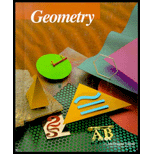
a.
To fill: The locus of point equidistant
a.
Answer to Problem 21WE
The locus of points
Explanation of Solution
Given:
Calculation:
Draw the points
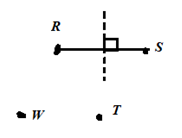
The locus of points equidistant from
Conclusion: Therefore, the complete statement is: The locus of points equidistant from
b.
To fill: The locus of points equidistant from
b.
Answer to Problem 21WE
The locus of points equidistant from
Explanation of Solution
Given:
Calculation:
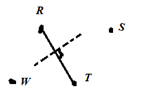
The locus of points equidistant from
Conclusion:
Therefore, the complete statement is: The locus of points equidistant from
c.
To fill: The loci found in parts (a) and ( b ) intersect in a ____ .and all points in this line are _______ from
c.
Answer to Problem 21WE
The loci found in parts (a) and ( b ) intersect in a line .and all points in this line are equidistant from
Explanation of Solution
Given:
Given statement: The loci found in parts ( a ) and ( b ) intersect in a line and all points in this line are equidistant from
Calculation:
The loci found in parts (a) and ( b ) intersect in a line .and all points in this line are equidistant from
This is because all points are in random position.
Conclusion:
Therefore, the complete statement is: The loci found in parts (a) and ( b ) intersect in a line and all points in this line are equidistant from
d.
To fill: The locus of points equidistant from
d.
Answer to Problem 21WE
The locus of points equidistant from
Explanation of Solution
Given:
Given statement: The locus points equidistant from
Calculation:
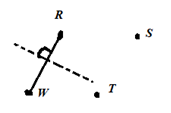
The locus of points
Conclusion:
Therefore, the complete statement is: The locus of points equidistant from
e.
To fill: The intersection of the figure found in ( c )and ( d ) is a _____. This _____ is equidistant from the four given points.
e.
Answer to Problem 21WE
The intersection of the figure found in ( c )and ( d ) is a point. This point is equidistant from the four given points.
Explanation of Solution
Given:
Given statement: The intersection of the figure found in ( c ) and ( d ) is a ?. This ? is equidistant from the four given points.
Calculation:
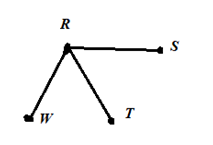
Conclusion:
Therefore, the complete statement is: The intersection of the figure found in ( c ) and ( d ) is a point. This point is equidistant from the four given points.
Chapter 10 Solutions
McDougal Littell Jurgensen Geometry: Student Edition Geometry
Additional Math Textbook Solutions
A First Course in Probability (10th Edition)
Thinking Mathematically (6th Edition)
Basic Business Statistics, Student Value Edition
Elementary Statistics: Picturing the World (7th Edition)
University Calculus: Early Transcendentals (4th Edition)
Intro Stats, Books a la Carte Edition (5th Edition)
- find the value of each variablearrow_forwardName: Date: Bell: Unit 11: Volume & Surface Area Homework 2: Area of Sectors Directions: Find the area of each shaded sector. Round to the hundredths place. 1. GH 11 in 2. KL 20 ft H F 64 G L 119 M K 3. BA 6.5 cm 4. YZ 14.2 m B 23 X 87° Y Z 5. KL = 27.1 mm J 32 L X:360-32.1 K A-3 360 7. BD 18 cm E 136 B X=32.8 127.0 (271) A: 069.13 Amm² 19=2102.13 A-136 360.16912 A:300cm² A=96.13 6. PQ = 2.8 in P R 311° 8. WZ 5.3 km V = Z 108 W D 9. HK = 25 ft G H KO 26 X 10. SR 26 m = S 73 T R Gina Wilson (All Things Algebarrow_forward538 Chapter 13 12. Given: Points E(-4, 1), F(2, 3), G(4, 9), and H(-2, 7) a. Show that EFGH is a rhombus. b. Use slopes to verify that the diagonals are perpendicular. 13. Given: Points R(-4, 5), S(-1, 9), T(7, 3) and U(4, -1) a. Show that RSTU is a rectangle. b. Use the distance formula to verify that the diagonals are congruent. 14. Given: Points N(-1, -5), O(0, 0), P(3, 2), and 2(8, 1) a. Show that NOPQ is an isosceles trapezoid. b. Show that the diagonals are congruent. Decide what special type of quadrilateral HIJK is. Then prove that your answer is correct. 15. H(0, 0) 16. H(0, 1) 17. H(7, 5) 18. H(-3, -3) I(5, 0) I(2,-3) 1(8, 3) I(-5, -6) J(7, 9) K(1, 9) J(-2, -1) K(-4, 3) J(0, -1) K(-1, 1) J(4, -5) K(6,-2) 19. Point N(3, - 4) lies on the circle x² + y² = 25. What is the slope of the (Hint: Recall Theorem 9-1.) - line that is tangent to the circle at N? 20. Point P(6, 7) lies on the circle (x + 2)² + (y − 1)² = 100. What is the slope of the line that is tangent to the circle at…arrow_forward
- Can you cut the 12 glass triangles from a sheet of glass that is 4 feet by 8 feet? If so, how can it be done?arrow_forwardCan you cut 12 glass triangles from a sheet of glass that is 4 feet by 8 feet? If so, draw a diagram of how it can be done.arrow_forwardIn triangle with sides of lengths a, b and c the angle a lays opposite to a. Prove the following inequality sin a 2√bc C α b a Warrow_forward
- Find the values of x, y, and z. Round to the nearest tenth, if necessary. 8, 23arrow_forward11 In the Pharlemina's Favorite quilt pattern below, vega-pxe-frame describe a motion that will take part (a) green to part (b) blue. Part (a) Part (b)arrow_forward5. 156 m/WXY = 59° 63 E 7. B E 101 C mFE = 6. 68° 8. C 17arrow_forward
- 1/6/25, 3:55 PM Question: 14 Similar right triangles EFG and HIJ are shown. re of 120 √65 adjacent E hypotenuse adjaca H hypotenuse Item Bank | DnA Er:nollesup .es/prist Sisupe ed 12um jerit out i al F 4 G I oppe J 18009 90 ODPO ysma brs & eaus ps sd jon yem What is the value of tan J? ed on yem O broppo 4 ○ A. √65 Qx oppoEF Adj art saused taupe ed for yem 4 ○ B. √65 29 asipnisht riod 916 zelprisht rad √65 4 O ○ C. 4 √65 O D. VIS 9 OD elimiz 916 aelonsider saused supsarrow_forwardFind all anglesarrow_forwardFind U V . 10 U V T 64° Write your answer as an integer or as a decimal rounded to the nearest tenth. U V = Entregararrow_forward
 Elementary Geometry For College Students, 7eGeometryISBN:9781337614085Author:Alexander, Daniel C.; Koeberlein, Geralyn M.Publisher:Cengage,
Elementary Geometry For College Students, 7eGeometryISBN:9781337614085Author:Alexander, Daniel C.; Koeberlein, Geralyn M.Publisher:Cengage, Elementary Geometry for College StudentsGeometryISBN:9781285195698Author:Daniel C. Alexander, Geralyn M. KoeberleinPublisher:Cengage Learning
Elementary Geometry for College StudentsGeometryISBN:9781285195698Author:Daniel C. Alexander, Geralyn M. KoeberleinPublisher:Cengage Learning

